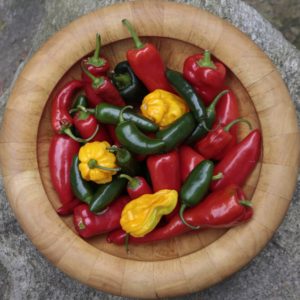Summer’s heat gives pepper lovers sweet abundance
And the ways cooks can preserve both hot and sweet ones are equally bounteous.
By CHRISTINE BURNS RUDALEVIGE – Portland Press Herald

Peppers love heat so this summer’s steamy temperatures have led to an abundance of the veggies in all colors and varieties. Derek Davis/Staff Photographer
Peppers are very hot right now, even the sweet ones.
At my favorite Friday morning farmers market in Brunswick, I counted 18 different varieties. I bought a bagful, let them sit beautifully in a bowl for a day, and then had to figure out what to do with them.
Those over 80-degree summer days (21 in July, 20 in August here in southern Maine) were just the right temperature for Capsicum to thrive, says Source’s own garden guru Tom Atwell. Roberta Bailey of Seven Trees Farm in Vassalboro has been growing all sorts of peppers since the 1980s. She confirmed this summer was indeed a great year for peppers, more so for sweet than hot, but both are bounteous.
Bailey cultivates Czech Black (her favorite!), Fish, Hidalgo serrano (her other favorite), Matchbox and Thai Hot for seed for Fedco Seeds in Waterville. She removes the seeds from her peppers, steams the flesh, purees it with garlic, and mixes it with the same amount of either cooked carrots or sweet potato to make a hot sauce akin to a Thai Sriracha.
Another way to preserve the 2016 pepper season would be to save seeds from this year’s fruit to plant next spring. Make sure your peppers came from open-pollinated parents if you’d like to reproduce the very same kind of pepper, Bailey warned. If your pepper is a hybrid, you can still save the seeds and plant them, but you could very well get a plant resembling any of the varieties crossed to produce the hybrid you liked, she said.
Grey Goose Gourmet pepper jellies are made in Wayne with primarily local peppers, owner Sandra Dwight-Barris said. The company’s Original Pepper Jelly, crafted from a recipe Dwight-Barris’ mother gave her 25 years ago, includes bell peppers, as well. “This coming year we will be using 100 percent local peppers,” said Dwight-Barris, in part because of the bumper crop and in part because she bought a new freezer, as the five she filled last year with processed pepper jelly starter didn’t meet demand.
To freeze the peppers, she washes and stems them, deseeding some to keep the heat in check. She uses a powerful blender to make a pulp, which she then freezes in containers measured out for her batches of jelly. Freezing them diminishes neither the flavor nor the heat, she said.
Homesteader and blogger Rachel Arsenault says her hot peppers – the Anaheim, jalapeño, Hungarian wax she grew from commercial seed and the experimental ones she collected from dried de arbol, japones and guajillo chillies – are all coming off the plants much hotter than they were last year. She dries her fair share in a dehydrator and stores them in jars, but she also likes to blister them on the grill as a key ingredient in huge batches of salsa, which she then freezes.
To freeze the King of the North bell peppers she grows, Arsenault slices them into strips before placing them in freezer bags for use in fajitas during the winter months. She freezes jalapeño peppers whole, explaining that they are easy to chop when partially frozen.
Portland’s Sur Lie chef Emil Rivera is partial to pickled peppers. He uses a house brine of Champagne vinegar seasoned with black pepper; and coriander, mustard and fennel seeds to pickle mild cherry bomb and shishito peppers, which softens the texture of the flesh and adds an obvious sour note to cut rich dishes like the restaurant’s braised short ribs.
Rivera also juliennes jalapeños to sauté very lightly with local mushrooms and butter and stuffs poblanos with whatever strikes his fancy on any given day.
As is traditional in a tapas place, Rivera also serves grill-blistered Padrón peppers sprinkled with sea salt. Eaters play a Russian roulette of sorts with these, because they don’t know which ones are mild and which ones are numbing. Rivera says this summer’s weather has increased his diners’ chances of getting a hot one by threefold.
I am a self-proclaimed heat wimp, so I won’t be playing with Padrón. I like to manage the heat of my preserved peppers, tasting a tiny bit of each one as I slice them for jars of Candied Mixed Peppers so I can balance the really hot ones with a calming selection of the sweeter ones.
To each his own, I guess. Fortunately for pepper eaters this year, we do not want for choices.
Christine Burns Rudalevige is a food writer, a recipe developer and tester, and a cooking teacher in Brunswick. Contact her at: cburn1227@gmail.com.

